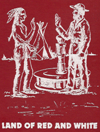 HARRY AND HAZEL
HARRY AND HAZEL
as told by Harry G. Jenner
Inglenook, I love that name. I spent my childhood and youth on Inglenook farm after coming to Frog Lake with Mother and Dad from Ash, Kent County, England. I was born on May 28, 1906 in the house they had named Inglenook. Mother and I left England July 7, 1911, on the ship Victorian and landed at Quebec. My only memory of the boat is of climbing up a ladder into a berth above my mother's but it is a pretty dim memory.
I had a happy childhood. There is a spruce swamp on the quarter north of Inglenook Farm where I spent many happy hours playing with my chums, or wandering with them down the cattle path that led to Frog Creek, which ran through the east side of our farm. We used to hunt rabbits, partridge, prairie chickens, and ducks along its banks and once in a while we would catch jackfish or suckers. I started school at Martin but switched to Frog Lake, where Alex Peterson was teaching, when Martin School closed because of too few pupils. However, as Dad needed my help on the farm in the summer and school closed down during the winter months, my education was pretty limited. I was their only child for several years as my sister Winnifred wasn't born until 1918.
Dad and I were plowing a fire guard around our pig pasture with a walking plow when I plowed up an Indian war-club. It was polished very smooth and had a grain resembling a wood grain; I wondered if it was petrified wood. It had markings on it. Some of the old Indians told us that the markings meant thunder and lightning and that it was mostly used for killing small game. Not realizing its potential value, when a traveller was going through here and offered Dad $5.00 for it and said he wanted to put it in a museum in Ottawa, Dad sold it. I don't know if it was ever put in the museum or not but I have always regretted letting it go.

I was about fifteen years old when Corporal Pearson invited me to visit with him and his family at the Onion Lake detachment. They were going to the Lloydminster Fair and thought I would enjoy going with them. That was my first ride in a buckboard; the only springs on the "police vehicle" was the spring seat. Before he would take me to the fair, the Corporal said he must shave the fuzz off my face. When he opened that old-fashioned straight razor and came toward me, I was scared! However, his touch was as light as a feather. That was my first shave with a straight razor. We travelled the fifty (approximate) miles to the fair in the buckboard. The fair ran for three days so we made the Lloydminster Police Barracks our headquarters while we were there. I enjoyed that almost as much as I did the fair.
At odd times I worked as a clerk for Mahmud Rahall who owned a store at Frog Lake. He told me that a pound of silver money, whether nickels, dimes, quarters, fifty cent pieces or silver dollars, counted out to exactly eleven dollars. Silver was silver in those days. My first car was a Model T Ford I bought in 1929 from Art Bowtell of Mooswa. After the deal was closed Art said I was too green to drive home after dark and coaxed me to stay the night; it would be safer if I drove it home the first time in daylight. Being afraid that Mother and Dad would worry I proudly got behind the wheel and although it was dark and I nearly hit a tree I got it home safe and sound. My friends and I had many good times with that old car. The roads around here were so terrible that even the notorious Model T's had a turn at being insulted by the horse while parked hub deep in mud holes. Likewise there was always the chance that I would have to "get out and get under" when the weather was the worst. After I began to take my girl out I discovered that Hazel was pretty slick at keeping the car in running order.
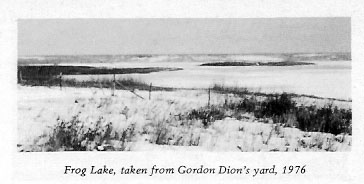
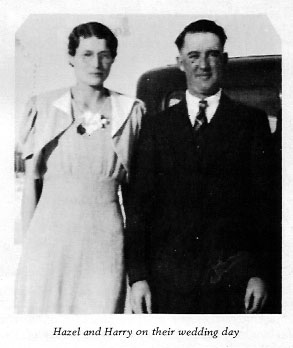
Box socials and masquerades were a popular form of entertainment. Everyone dressed in homemade costumes and acted the part. Old Time, Hard Time dances were fun, the ladies dressed in cotton dresses and the gents in overalls. Anyone wearing silks, jewellry of any kind, white shirts, watches or neckties etc. had to pay a fine. Proceeds went toward buying hockey or baseball equipment, donations to the needy, and one was held for the purpose of donating a bed to the Elk Point Hospital.
Gerald Lawrence organized an old time orchestra and in 1934 he talked me into buying a set of drums. I had inherited my parents love of music but had never seriously tried to play any instrument. I had an ear for music and had learned to whistle in accompaniment to the folks as they played the piano and sang. I learned to imitate bird calls and loved to hear them answer me. It was fun too, to watch the gophers sit up and listen, trying to locate the other "gopher" that whistled to them. Therefore I didn't need much persuasion. I heard that Mr. H.E. Hobden, of Armistice, had a set for sale. George Parson and I made the trip, staying overnight with Erling Sand and family. Erling was Gerald Lawrence's brother-in-law. I bought the drums for thirty dollars and became a member of the Heinsburg Old Timers. Those drums became the joy of my life. The original members were Gerald Lawrence, violinist; his wife Anne and George Parson played guitars, and I beat the drums. One year I kept track of all the places we played. The distance we travelled in that one year was 1,500 miles. The outside points were Cold Lake, north; Provost, south; Edmonton, west; and Maidstone, Saskatchewan to the east. In fact there are very few halls within that circle where we haven't been asked to play for dances.
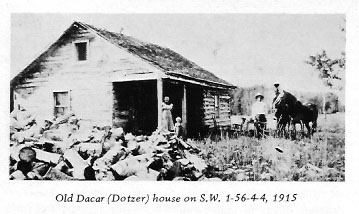
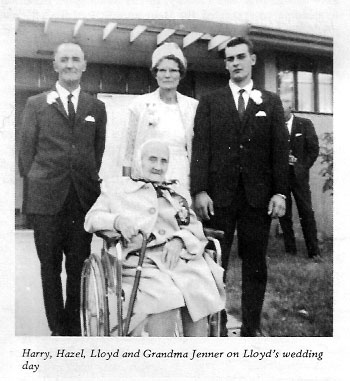
In 1939 Hazel and I were married. Hazel, daughter of Bob and Clara Blais, never knew her mother who passed away when Hazel was born. She, Hazel, was raised by her father's sister; first Aunt Hattie of Warwick, Alberta, who passed away when Hazel was four, so her cousins, Hattie's daughter and husband, Hazel and Ed Lorenson took her under their wing. They moved from Warwick, Alberta, where Hazel had attended school, to a farm at Heinsburg in 1930. She has two sisters, Alice and Ruth, also raised by their aunts. Her only brother, Lloyd remained with their father until Lloyd passed away at the age of twenty-three. Hazel loves the outdoors, and became a wonderful help on our farm, often keeping the home fires burning while I went with the orchestra. She is handy with a hammer and nails and does a good job of keeping our buildings repaired. Dad still needed my help on the farm so we moved the house that I had purchased from Ruby Reishus, onto Inglenook Farm and that was our home until 1940. Then we bought the S.W. 1-56-4-W4th from Phil Sillem and started farming on our own; things went along pretty smooth for us.
I wonder if anyone has mentioned Pelican Island and the Old Ford where we used to cross Frog Creek on the Indian Reserve, north-east of the bridge. This interesting little island is located in Frog Lake about a quarter of a mile from the west shore. I believe it was named Pelican Island by the local residents because each spring hundreds of pelicans nested and raised their young there. It became quite a tourist attraction but the big birds were disturbed so often that they became discouraged and changed their nesting grounds. We used to see huge flocks flapping their way, three flaps and a glide, in V formation, over our farms. Now it is a novelty to see one or two birds a season.
Many years ago George and Jean Kinch, Hazel and myself visited Pelican Island. It was a beautiful summer day. The water between shore and the Island was little more than waist deep so we waded across. Pelicans on land are pretty ungainly creatures. The young, when we were there, had not begun to feather out and were completely naked. I found the sight of the adult birds feeding their young quite unpleasant. They store the food in their pouch and regurgitate it into the open beak of the young ones. After wading back to shore we noticed a nice potato patch near by. We knew it belonged to an Indian neighbor but since no one was home we dug up a hill and fried them in butter over the camp fire. They were the best new potatoes I have ever tasted. However I don't think it was approved of because an unnoticed storm cloud poured its water over us in torrents. The underside of the buggy gave little protection so we hitched up the team and headed for home.
Frog Creek, usually so friendly, showed its disapproval. When we crossed the Old Ford on the way to the lake it was almost dry. When we came back the water was rushing and pretty deep; the horses plunged in and the buggy bogged down in midstream. The water covered the floor boards. The horses gave a lunge and the single tree broke in half. We vowed never to swipe another hill of new potatoes. Fortunately the creek isn't very wide so I waded ashore and cut a green willow about half an inch in diameter. George and I waded to the front of the buggy, laid it behind the broken single tree and wired them together with a piece of haywire so we could still use the end clips of the single tree for hooking onto the traces. Before we got out of the creek that green willow stick bent almost double but didn't break and brought us home.
That handy piece of haywire was "a must" for farmers. We took a length with us wherever we went. Because of it the name "Haywire Farmer" came into being, but it often saved us two or three days of lost time. Machinery could often be cobbled up for work with it while someone made the forty-mile trip to the nearest town for a bolt or fifty-cent repair. Often, as the trip would take two or three days, the haywire made it possible to get grain cut, etc. while the weather permitted.
Our son, Lloyd, was born in 1946. At present he lives in Heinsburg and works at the Lindbergh Salt Plant. He married the former Judy Ballas They have two boys and one girl - Jason, Jolie and Lindsay. In 1957 I accepted the offer to become caretaker of the Heinsburg School. I really enjoyed the work and the following year we rented our farm to Donald Kjenner, puchasing the house that Steve Palylyk had previously moved onto the hillside overlooking the hamlet of Heinsburg and the river. Alex Peterson and his bride Belle, owned and lived in this house on their farm while Alex taught at Frog Lake School some fifty years ago. It is still our home.
After watching the televised first landing on the moon I went outside, looked at the full moon and thought, "There are two men on that moon up there. It doesn't seem possible, but they are there." I have now retired but still enjoy helping out around the school. I am the only original member of the Heinsburg Old Timers still living in this district but the orchestra is still active: The present members are: Ed Smuk, accordian; Leonard Sawak, guitar; Willie Osinchuk, violin; Willie's son Darrell, saxaphone and I still beat those same drums I purchased for thirty dollars in 1934. When we recently made an appearance on the CKSA Talent Show, host Barry Smith remarked that Ed Smuk "had to be" the only left-handed accordian player in captivity.


